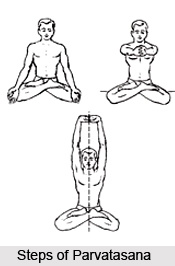 Parvatasana is a cultural asana that has come through tradition. The body assumes the shape of a hill in this asana hence; the name is derived as Parvatasana, from parvata, a Sanskrit term for mountains. It has myriad benefits and is one among the yoga postures for weight loss.
Parvatasana is a cultural asana that has come through tradition. The body assumes the shape of a hill in this asana hence; the name is derived as Parvatasana, from parvata, a Sanskrit term for mountains. It has myriad benefits and is one among the yoga postures for weight loss.
Method of Parvatasana
The method of Parvatasana is provided below with step by stepdescriptions:
•Firstly, one has to sit in Padmasana pose. Then raise the hands towards sky and keep palms facing each other.
•One must hold the fist of one hand with the other hand and stretch the hands upward as if he/she is raising the body. The person will witness stretch in the abdominal muscles.
•After maintaining it for sometimes, one has to loosen the hands and then practice it again.
•Beginners can practice this asana for 10-15 minutes. Once they are comfortable and confident, the timing can be stretched further.
People, who cannot practise Padmasana, can practise Parvatasana by standing with stretched legs or in the pose of Vajrasana. However, sitting erect and gazing in front is essentially important in Parvatasana.
Benefits of Parvatasana
•Practice of Parvatasana makes the spine flexible.
•Visceroptosis and pain in backbone is also cured if Parvatasana is performed.
•Parvatasana is beneficial in constipation and removes seminal weakness.
•This yoga practice also helps practitioners below 18 years to gain some height.
•It reduces extra fat in the back and waist.
•It tones the abdominal muscles and hence stimulates the inner organs in the abdominal region.
•It helps to reduce back pain.
•It sets right respiratory disorders including asthma.
•It gives natural massage to the heart and lung muscle.
•It reduces lumber, spinal, shoulder, and ankle pains.
•It relieves carpal tunnel syndrome, rheumatic stiffness, and arthritis.
•It ensures good blood circulation.
•It reduces mental fatigue and improves memory.
•It improves concentration and helps in gaining self confidence.
•Parvatasana can be practiced for toning almost all the body`s muscles.
Precautions in the Practice of Parvatasana
•Those having complaints of reeling sensation should not practise Parvatasana.
•People with knee problems should avoid this asana.



